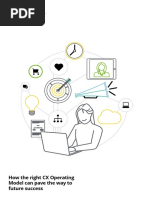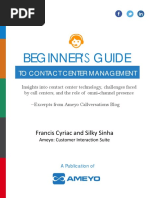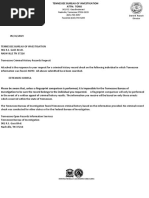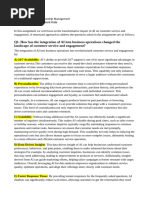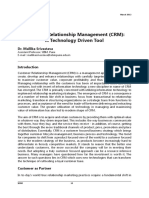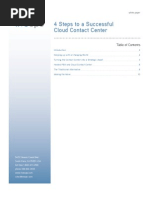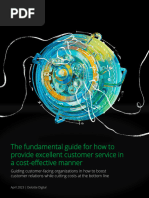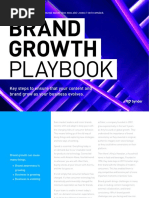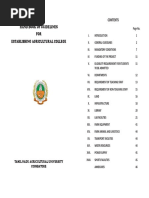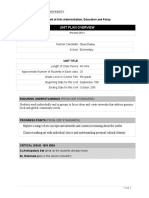Make Your CX Efforts Sing With Channel Orchestration
Make Your CX Efforts Sing With Channel Orchestration
Uploaded by
LadyRiRiCopyright:
Available Formats
Make Your CX Efforts Sing With Channel Orchestration
Make Your CX Efforts Sing With Channel Orchestration
Uploaded by
LadyRiRiOriginal Title
Copyright
Available Formats
Share this document
Did you find this document useful?
Is this content inappropriate?
Copyright:
Available Formats
Make Your CX Efforts Sing With Channel Orchestration
Make Your CX Efforts Sing With Channel Orchestration
Uploaded by
LadyRiRiCopyright:
Available Formats
W H I T E PA P E R
Make Your CX Efforts Sing
with Channel Orchestration
4 keys to successfully integrating traditional and digital
channels for CX and operational excellence.
W H I T E PA P E R
Overview
Companies get it. Customers want fast, convenient, and frictionless support.
That’s why businesses are investing in digital transformation initiatives that
improve the customer experience. From social media and mobile apps to chat,
video, and voice, there are many ways for businesses to support customers.
However, it’s not uncommon for customers to miss or ignore some of these
tools. A focus on channel orchestration that aligns the best channels to the right
interactions is at the core of a successful digital transformation.
The good news is there are ways to solve these issues with robust data analytics
and a deep understanding of customer needs and behavior.
A focus on channel
orchestration that aligns
Read this whitepaper to learn:
the best channels to the
Why customers continue to make voice calls—even when better
right interactions is at
options exist
the core of a successful
How channel orchestration enables companies to balance customer
expectations with business needs
digital transformation.
How a financial services company used channel orchestration to save
nearly $3 million annually
How to successfully apply channel orchestration to your
organization’s needs
TABLE OF CONTENTS
Work smarter, not harder......................................................... 2
How channel orchestration can help....................................... 3
4 keys to successful channel orchestration............................ 4
Channel orchestration in action………………………………………... 5
A note about metrics................................................................ 5
Harmonious support hinges on customer understanding .... 8
About TTEC............................................................................... 9
1 ©2019 TTEC. All rights reserved.
W H I T E PA P E R
Work smarter,
not harder
Though voice calls are still the most common But it can be equally frustrating to wait several minutes
route for a majority of customer service and other just to ask a quick question or be forced to repeat
brand communications, customers just want their questions multiple times.
problem solved quickly, regardless of whether they’re
This leaves companies with an undesirable scenario:
communicating with a human or a bot. Yes, some people
spending a lot of money to deliver a poor experience
prefer human touch, but others are fine with as little
to the customer. What’s more, numerous studies have
human intervention as possible. That’s why bots and self-
shown that consumers will switch providers after just
service options are on the rise.
one bad customer service experience. More companies
However, bots have limited uses—the average bot can are therefore coming to the realization that they need
only respond to straightforward questions and perform to overhaul their customer experience and provide
simple tasks. As a result, many customers turn to what’s customers with the right kind of support, in both digital
familiar: making a phone call. This tendency isn’t limited to and traditional channels.
Baby Boomers, either. In fact, millennials call their bank at
nearly three times the rate of older customers, according
to a study by Bain & Company. However, bots have limited uses—
the average bot can only respond to
straightforward questions and perform
simple tasks.
2 ©2019 TTEC. All rights reserved.
W H I T E PA P E R
How channel
orchestration can help
Adopting the latest contact center technologies
and tools to modernize the customer experience
is one thing, but it’s another to create a seamless
experience that effectively integrates multiple
traditional and digital support channels to balance
customer expectations and business needs.
Just as an orchestra is composed of various
instruments, channel orchestration brings
different interaction channels together to perform
harmoniously for the customer. As a result,
customers receive faster and more effective service.
What’s more, adding operational efficiencies
eliminates extraneous uses of company resources
and employee effort to increase savings.
Channel orchestration
leverages customer
preferences for different
channels while driving down
costs and improving the
quality of the experience.
3 ©2019 TTEC. All rights reserved.
W H I T E PA P E R
4 keys to successful channel orchestration
Partnership
Collaboration and open dialogue between various stakeholders across channels and lines of business is
important for developing initiatives in which everyone feels ownership. Appointing a dedicated change
management team or point person to provide focus and keep track of the initiative’s progress is also important.
Contact center operational expertise
Associates are at the heart of any changes made to the customer experience. A deep understanding of
associate workflow, tools, and challenges is essential to ensure initiatives fit into the associate’s daily flow and
has a minimal impact on average handle time or call resolution.
Rigorous test-and-learn design
By addressing a measurement plan at the beginning of the process and designing a solid test-and-learn
methodology, brands will be able to gain valuable insights during the pilot period and deep drilldowns at the
end of the initiative to inform future efforts.
Detailed rollout plan
Providing a data-driven prioritization of future efforts and a fact-based business case based on quantitative
insights helps gain senior leadership buy-in. The goal is to have all necessary parties ready, willing, and able to
go live with the initiative and begin realizing the benefits as quickly as possible.
4 ©2019 TTEC. All rights reserved.
W H I T E PA P E R
A note about metrics
Identifying the metrics to guide a channel orchestration These questions will help determine the scope and direction
strategy and measure its success is also critical. Before of the initiative. Additionally, channel orchestration metrics
deploying the initiative, there are several key questions to are becoming more personalized and outcome-driven,
consider: Which channels are my customers using? What versus being solely focused on operational effectiveness.
would constitute success? If the goal, for example, is to For instance, in addition to focusing on average handle time,
transition customers to self-service, what percentage of service level, and other operational metrics, companies
customer transactions are already completed in self-service are increasingly asking about outcome-based metrics like
versus other channels like voice? And what percentage of customer effort score, NPS, and customer satisfaction.
those phone calls could be resolved through self service?
CLIENT STORY
Channel orchestration in action
A financial services client was experiencing high call volumes in its contact center, despite efforts to digitally transform the
customer experience. Although the firm offered robust mobile and digital self-service options (SSO), there was a group of
frequent callers who continued to rely solely on the phone to handle all their banking needs.
To address the problem, we started with an evaluation of the call volumes. The analysis helped identify four customer
segments, each with a different reason for calling. The four segments were: No self-service option; not aware of self-service;
tried self-service unsuccessfully; and aware of self-service option but didn’t try it.
5 ©2019 TTEC. All rights reserved.
W H I T E PA P E R
Figure 1: Different strategies for unique customer segments
Customer segment Percent of frequent callers Strategy
No SSO for call reason 33% Identify opportunities to create new SSOs
Not aware of SSO 20% Educate about SSOs available to them
Identify reasons for SSO failure and
Tried SSO unsuccessfully 29%
opportunities to improve current SSO offerings
Aware of SSO but didn’t try it 18% Explore reasons for reluctance to use SSO
Source: TTEC
Our next step was to launch a test-and-control pilot to identify the segments that were most likely to respond to a
customer education program on the benefits of self-service channels.
−− Frequent callers were directed to pilot or control associates. Control associates performed their duties as usual, but the pilot
associates offered the caller information about the self-service options.
−− The primary objective of the Caller Education Inbound Pilot was to deflect future frequent callers (digitally active and non-
digitally active) to self-service/digital channels through a series of bundled communications and call treatments. This pilot
provided frequent callers consistent, enhanced service throughout the pilot period.
−− Pilot associates educated callers using advanced features such as co-browse, simulator, and other personalization methods.
Associates also followed up with a personalized email to customers to reinforce the self-service functionality, or walked the
customer through a demonstration of the self-service IVR.
6 ©2019 TTEC. All rights reserved.
W H I T E PA P E R
Figure 2: Caller education pilot program steps
1. Pilot experiment design – Rigorous test vs.
control design for pilot program(s) to ensure
readable and statistically significant results.
2. Data fusion – Automated data ingestion and
integration of key data elements form disparate
sources.
3. Automated insights – Near real time visualization
of results highlighting collaboratively identified KPIs.
4. Advanced analytics – Deeper dive into insights
beyond base KPIs into the who, why, what, when,
and how often as well as potentially combining
unstructured VOC data.
5. Business case development – Financial impact
assessment and go-forward recommendations.
6. Enterprise rollout – Enterprise-wide
measurement design, recommendations for
additional visualizations and recommendations for
Source: TTEC Digital ongoing data fusion and measurement.
Having a test-and-control framework enabled us to drill into the data and produce insights that would have been impossible
to produce otherwise. For example, we determined that caller education helped reduce call volume for only certain call reasons.
This finding helped reduce the AHT impact of the program because associates only offered education where it reduced
call volume.
Results
The Caller Education pilot helped reduce the 30-day callback rate by 18 percent. These improvements were sustained in 60-
day and 90-day call back rates. Supported by these findings, we developed a data-driven rollout plan (prioritized by call reason)
that provided close to $3 million in annual savings for the company.
By analyzing the reasons customers were calling and developing a test-and-control model to refine those insights, we identified
the most effective way to address the problem—unnecessarily high call volumes—and direct callers to other options that
better met their needs. This also enabled associates to focus on more complex consultative calls or account issues. As a result,
customers received better service and the client reduced unnecessary costs (e.g., employing associates to answer tier 1 or
rote questions).
7 ©2019 TTEC. All rights reserved.
W H I T E PA P E R
Harmonious support hinges on
customer understanding
Just as an orchestra depends on the collaboration
and synchronization of its musicians, customer
support channels must be aligned in order to provide
optimal service. And if implemented correctly,
channel orchestration can help companies meet
customers’ different needs in a harmonious—and cost
effective—system.
Contact TTEC today to learn more about how to align the right channels
with the right interactions to create a harmonious customer experience.
8 ©2019 TTEC. All rights reserved.
ABOUT TTEC
TTEC (NASDAQ: TTEC) is a leading global customer experience technology and services company focused on the design, implementation and delivery
of transformative customer experience for many of the world’s most iconic and disruptive brands. The Company delivers outcome-based customer
engagement solutions through TTEC Digital, its digital consultancy that designs and builds human centric, tech-enabled, insight-driven customer
experience solutions for clients and TTEC Engage, its delivery center of excellence, that operates customer acquisition, care, fraud prevention and
detection, and content moderation services. Founded in 1982, the Company's 52,400 employees operate on six continents across the globe and live by a
set of customer-focused values that guide relationships with clients, their customers, and each other. To learn more about how TTEC is bringing humanity
to the customer experience, visit www.ttec.com.
solutions@ttec.com
800.835.3832
ttec.com
71405 3/19
You might also like
- Salesforce Industry Fullforce BrochureDocument78 pagesSalesforce Industry Fullforce BrochureMang UcupNo ratings yet
- CSEC Agricultural Science Syllabus With Specimen PapersDocument158 pagesCSEC Agricultural Science Syllabus With Specimen PapersTassell Eugene89% (9)
- Contact Center Express ProposalDocument72 pagesContact Center Express Proposalapi-3820599100% (4)
- Unconventional Warfare Pocket Guide - v1 0 - Final - 6 April 2016 PDFDocument199 pagesUnconventional Warfare Pocket Guide - v1 0 - Final - 6 April 2016 PDFnwg002100% (1)
- Deloitte Digital CX Operating Model PoVDocument24 pagesDeloitte Digital CX Operating Model PoVCleonpfNo ratings yet
- Transforming From Call Center To Contact Center Best Practices GuideDocument21 pagesTransforming From Call Center To Contact Center Best Practices GuideDemand Metric100% (1)
- Beginners Guide To Contact Center ManagementDocument64 pagesBeginners Guide To Contact Center ManagementBilly Willɪam100% (1)
- Accenture Contact Center of The Future Smart Selective Human Touch 170725024356Document26 pagesAccenture Contact Center of The Future Smart Selective Human Touch 170725024356alaadeen100No ratings yet
- The Real-Time Contact Center: Strategies, Tactics, and Technologies for Building a Profitable Service and Sales OperationFrom EverandThe Real-Time Contact Center: Strategies, Tactics, and Technologies for Building a Profitable Service and Sales OperationNo ratings yet
- Filosofia EducatieiDocument9 pagesFilosofia EducatieiRusov VeronicaNo ratings yet
- Adama Agricultural Machinery IndustryDocument2 pagesAdama Agricultural Machinery IndustryTsedeke Girma100% (5)
- Criminal History - KUMSSADocument5 pagesCriminal History - KUMSSAAnonymous GF8PPILW5No ratings yet
- Running Head: The Impact of Technology in Customer Satisfaction in BPO Companies 1Document17 pagesRunning Head: The Impact of Technology in Customer Satisfaction in BPO Companies 1Joshua Kyle GomezNo ratings yet
- Aspect Efficiency NOT EnoughDocument11 pagesAspect Efficiency NOT EnoughAkkiNo ratings yet
- How To Conduct A Call Center Performance Audit: A To ZDocument10 pagesHow To Conduct A Call Center Performance Audit: A To Zzareen.zehra100% (1)
- 10 Effective Call Center Operational Performance StrategiesDocument8 pages10 Effective Call Center Operational Performance StrategiesMuhammad Tahir NawazNo ratings yet
- G5a03mrrowhtijxmwu1w - Movement PDF Squashskills X PsaDocument22 pagesG5a03mrrowhtijxmwu1w - Movement PDF Squashskills X PsaAnmol SahoreNo ratings yet
- Towards Automated Customer Self-HelpDocument11 pagesTowards Automated Customer Self-HelpViking OmuNo ratings yet
- 001 Esker Workbook Customer Service usNPDcB0Yx68v4xitRRyd5qn4F7E9EpGFpIegMp72NDocument16 pages001 Esker Workbook Customer Service usNPDcB0Yx68v4xitRRyd5qn4F7E9EpGFpIegMp72NSazones Perú Gerardo SalazarNo ratings yet
- FINALBusiness Plan TemplateDocument8 pagesFINALBusiness Plan TemplateJoe MamaNo ratings yet
- Uc GHCC Digitalcx Whitepaper 185660Document6 pagesUc GHCC Digitalcx Whitepaper 185660tecame1312No ratings yet
- White Paper Prioritizing Organizational VitalityDocument14 pagesWhite Paper Prioritizing Organizational VitalityD.M. TrizmegistusNo ratings yet
- WP Unleash The Power of Total Experience in Telco Web NewDocument5 pagesWP Unleash The Power of Total Experience in Telco Web Newanantg7567No ratings yet
- Bringing Data Digital Together To Deliver A Smart Interaction CenterDocument18 pagesBringing Data Digital Together To Deliver A Smart Interaction CenterWalter MacuadaNo ratings yet
- Genesys Omnichannel Customer Engagement Playbook EB ENDocument17 pagesGenesys Omnichannel Customer Engagement Playbook EB ENTan LeNo ratings yet
- Seeing Is Believing PDFDocument9 pagesSeeing Is Believing PDFRamiro Idarraga GilNo ratings yet
- Digital Transformation PredictionsDocument24 pagesDigital Transformation Predictionsedison100% (2)
- Assignment 1 - CRM Sem IIDocument5 pagesAssignment 1 - CRM Sem IIpahaditrulyNo ratings yet
- Deploying A Contact Center in The Cloudin The CloudDocument12 pagesDeploying A Contact Center in The Cloudin The CloudQaisNo ratings yet
- 210207_fin-campaign_channel_strategy_finalDocument8 pages210207_fin-campaign_channel_strategy_finaltefera tashomeNo ratings yet
- Customer Relationship Management (CRM) : A Technology Driven ToolDocument12 pagesCustomer Relationship Management (CRM) : A Technology Driven ToolManickath Mani NairNo ratings yet
- Transforming From Call Center To Contact Center Best Practices GuideDocument16 pagesTransforming From Call Center To Contact Center Best Practices GuideDemand MetricNo ratings yet
- Customer Evolution Outside in Transformation Vol 6Document116 pagesCustomer Evolution Outside in Transformation Vol 6rprasannaa2002No ratings yet
- Forrester Dont Pass On Advanced CPaaSDocument18 pagesForrester Dont Pass On Advanced CPaaSErosUk LondonNo ratings yet
- Ways To Reduce Contact Center CostsDocument15 pagesWays To Reduce Contact Center CostsNoBleafNo ratings yet
- A Dynamic Customer Support SystemDocument32 pagesA Dynamic Customer Support SystemteesilveryNo ratings yet
- 28-Making A Great First ImpressionDocument12 pages28-Making A Great First ImpressionKharisma ViranataNo ratings yet
- UK Call Centre Environment Report 2004 FINALDocument11 pagesUK Call Centre Environment Report 2004 FINALmdabubakarshiblyNo ratings yet
- Fintech and The Customer Experience:: Best Practices, Trends and Expert InsightsDocument21 pagesFintech and The Customer Experience:: Best Practices, Trends and Expert Insightscarol laoNo ratings yet
- Design Your Contact Center From The Outside inDocument15 pagesDesign Your Contact Center From The Outside inShah Manzur E KhudaNo ratings yet
- End MomentDocument34 pagesEnd Momentmerchantraza14No ratings yet
- Gaming report 2024Document12 pagesGaming report 2024rashadrsd729No ratings yet
- Customer Service PDFDocument10 pagesCustomer Service PDFKarthik BhandaryNo ratings yet
- Operations Leaders Guide To CCTR SolutionsDocument12 pagesOperations Leaders Guide To CCTR SolutionsTefzenNo ratings yet
- Agility SMB Playbook v3 enGBDocument12 pagesAgility SMB Playbook v3 enGBMonika KravetzNo ratings yet
- Utopia Speech AnalyticsDocument9 pagesUtopia Speech AnalyticsJesse PaitNo ratings yet
- 4 Steps To A Successful Cloud Contact CenterDocument11 pages4 Steps To A Successful Cloud Contact CenterGanesan Ganesan KNo ratings yet
- 7 Steps To Improving CEMDocument15 pages7 Steps To Improving CEMTrần Hoàng DiệuNo ratings yet
- Ebook Omnichannel Marketing A Complete Guide For 2023Document20 pagesEbook Omnichannel Marketing A Complete Guide For 2023DECIOEDUARDONo ratings yet
- Ism Q&A2Document8 pagesIsm Q&A2Abhijeet PanditNo ratings yet
- Bridging The CX Gap ReportDocument56 pagesBridging The CX Gap ReportsabzinehNo ratings yet
- Enabling Conversations - Kuliah Umum Technopreneurship - It Is Time To BuildDocument38 pagesEnabling Conversations - Kuliah Umum Technopreneurship - It Is Time To BuildYudha sopyan KurniawanNo ratings yet
- A Study On Attrition AnalysisDocument60 pagesA Study On Attrition AnalysisroshiniylNo ratings yet
- Shared Service Center DissertationDocument7 pagesShared Service Center DissertationPaperWritingServicesLegitimateCanada100% (1)
- How To Optimize The: Efficiency of Your Call CenterDocument22 pagesHow To Optimize The: Efficiency of Your Call CenterNarayanNo ratings yet
- Customer Relationship ManagementDocument12 pagesCustomer Relationship ManagementEugene EugenioNo ratings yet
- BPO Future Forward IVDocument40 pagesBPO Future Forward IVSaurabh GuptaNo ratings yet
- Customer Support Trends 2022 ReportDocument28 pagesCustomer Support Trends 2022 ReportageNo ratings yet
- Call Center Iq Executive ReportDocument42 pagesCall Center Iq Executive ReportAnoosha HabibNo ratings yet
- Customer ServiceDocument23 pagesCustomer ServiceJohn PhilipNo ratings yet
- Role of Knowledge Management in Telecom SectorDocument24 pagesRole of Knowledge Management in Telecom Sectorsakshi88100% (3)
- Unit-9 Introduction To Service OperationDocument11 pagesUnit-9 Introduction To Service Operationdubeyvimal389No ratings yet
- Nice Report Experience Management May 2023JICndrrwVNRXJj2QVCGydVAHaxvDbsqzVmYbPVLJDocument6 pagesNice Report Experience Management May 2023JICndrrwVNRXJj2QVCGydVAHaxvDbsqzVmYbPVLJrene.carvajalNo ratings yet
- Bulletin PB20160197 - Introducing Mitel and ASC Technologies 1-2Document10 pagesBulletin PB20160197 - Introducing Mitel and ASC Technologies 1-2lykorianNo ratings yet
- Prompt Engineering White PaperDocument13 pagesPrompt Engineering White Paperblkusuma21No ratings yet
- ShockwavesDocument22 pagesShockwavesLadyRiRiNo ratings yet
- TikTok Marketing For BrandsDocument41 pagesTikTok Marketing For BrandsLadyRiRi100% (1)
- Brand GravityDocument26 pagesBrand GravityLadyRiRiNo ratings yet
- Marketing Fact Pack 2020Document36 pagesMarketing Fact Pack 2020LadyRiRi100% (1)
- Josh Bersin - HR Transformation in The Experience AgeDocument9 pagesJosh Bersin - HR Transformation in The Experience AgeLadyRiRiNo ratings yet
- Brand Growth Playbook PDFDocument36 pagesBrand Growth Playbook PDFLadyRiRiNo ratings yet
- 2019 Merkle Facebook Playbook Online PDFDocument20 pages2019 Merkle Facebook Playbook Online PDFLadyRiRiNo ratings yet
- FAACS Controlled AssetsDocument280 pagesFAACS Controlled AssetsKatie WatsonNo ratings yet
- Adelakun Adesoji Babatunde ResumeDocument10 pagesAdelakun Adesoji Babatunde Resumeapi-366039066No ratings yet
- Student Guide Book - Faculty of Engineering TechnologyDocument84 pagesStudent Guide Book - Faculty of Engineering TechnologyShera0% (1)
- HUL Distribution Network (Final Presentation)Document22 pagesHUL Distribution Network (Final Presentation)angihpNo ratings yet
- RIZALDocument4 pagesRIZALYoanne Marie TeroNo ratings yet
- Ghana Airport Company Limited Rescue and Firefighting Service (RFFS)Document7 pagesGhana Airport Company Limited Rescue and Firefighting Service (RFFS)frank brobbey0% (1)
- Republic Act 9155Document29 pagesRepublic Act 9155Imee LintagNo ratings yet
- Development of A Quality Design Framework For Usable User InterfacesDocument5 pagesDevelopment of A Quality Design Framework For Usable User Interfacesandre ramdhanNo ratings yet
- Content Marketing Hubspot GuideDocument12 pagesContent Marketing Hubspot GuideAbdelhady El HendawyNo ratings yet
- Hand Book of Establishing Agriculture College in IndiaDocument32 pagesHand Book of Establishing Agriculture College in IndiaRaj Kumar100% (1)
- Class Manual For Ucanspeak Level 1 4: 30 Sec. 1 Min. 1 Min. 1. GreetingsDocument1 pageClass Manual For Ucanspeak Level 1 4: 30 Sec. 1 Min. 1 Min. 1. GreetingsChristine Aev OlasaNo ratings yet
- Value Analysis Value EngineeringDocument25 pagesValue Analysis Value Engineeringeebeep100% (2)
- Position Paper - DisplacementDocument7 pagesPosition Paper - DisplacementLeo Archival ImperialNo ratings yet
- SIMMs Narrative Report 2Document12 pagesSIMMs Narrative Report 2ROWENA ARAGON50% (2)
- CRPC Group 8Document10 pagesCRPC Group 8Olivia DeyNo ratings yet
- Spelling Data AnalysisDocument14 pagesSpelling Data AnalysisLydiaRyoo100% (1)
- Lesson One Draft-CommunityDocument16 pagesLesson One Draft-Communityapi-582819687No ratings yet
- Alliance Theory and Alliance Shelter': The Complexities of Small State Alliance BehaviourDocument19 pagesAlliance Theory and Alliance Shelter': The Complexities of Small State Alliance BehaviourLivia StaicuNo ratings yet
- Distance Travelled Daily (KM)Document7 pagesDistance Travelled Daily (KM)Nishant BhamareNo ratings yet
- Asking Appropriate QuestionsDocument14 pagesAsking Appropriate QuestionsyowaNo ratings yet
- Sustained Shared ThinkingDocument4 pagesSustained Shared ThinkingSusan JackmanNo ratings yet
- Agamben - What Is A ParadigmDocument15 pagesAgamben - What Is A Paradigmdontor100% (2)
- 10 Billion Strong 2021 Annual ReportDocument9 pages10 Billion Strong 2021 Annual ReportPatrick ArnoldNo ratings yet
- Answering Bar Questions GuideDocument6 pagesAnswering Bar Questions GuideBabba Jamel Mamutuk50% (2)
- Road To SuccessDocument266 pagesRoad To SuccessLolitha VelayudhanNo ratings yet




